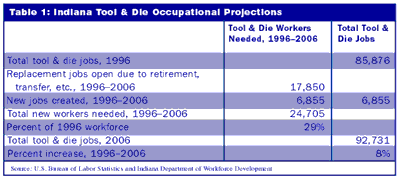Casting a Stamp on the Future
Indiana has a rich tradition in the tool and die industry. Its high-skill, high-wage jobs have supported the state's manufacturing base for decades. As firms compete for skilled workers, what challenges can the industry expect in the future?
The Indiana Department of Workforce Development's (DWD) long-term projections can help answer this question. In conjunction with the Bureau of Labor Statistics, DWD is able to project short- and long-term staffing patterns for 664 different occupations at both the state and local levels. What is unique about DWD's calculations is the estimation of not only natural job growth but also replacement jobs, defined as people leaving the workforce for reasons such as retirement or those taking jobs in other occupations. "IN the Details" explains the forecasting methodology in greater detail.
DWD identified 23 skilled tool and die occupations statewide. Unskilled labor, supervisors, and administrative and support positions were excluded from the analysis. In 1996, 85,876 people were employed in these 23 skilled tool and die positions statewide. This represented more than 12% of Indiana's manufacturing workforce. DWD estimates the tool and die workforce will total 92,731 in 2006, an 8% increase from 1996 (see Table 1). This averages about 685 new jobs each year.

The top five tool and die growth occupations are numerical control machine operators, combination machine tool setters, combination machine tool operators/tenders, machine shop sheet metal workers and non-classified precision workers. The five occupations with the largest declines are drilling/bore machine setters/operators, grinding machine setters/operators, maintenance and production (M/P), punching machine setters/operators (M/P), foundry mold and core makers, and machine forming operators (M/P).
An 8% growth rate for skilled tool and die jobs between 1996 and 2006 may not appear significant, but when replacement jobs for the industry are included, another picture emerges. Table 1 shows that 17,850—21% of the employees working in machine shop-related jobs—will have to be replaced statewide between 1996 and 2006. Occupations experiencing the most turnover are machinists, machine forming operators, numerical control machine operators, combination machine tool setters and combination machine tool operator/tenders.
When tool and die replacements are combined with new jobs, the workforce picture becomes clearer. Between 1996 and 2006 the industry will need a total of 24,705 new and replacement workers across the state, or 29% of the 1996 tool and die workforce. This equals 2,470 jobs annually. The main reason the Hoosier tool and die industry may face challenges in finding skilled workers is the number of workers leaving the industry, largely due to retirement.
One reason for this may be that many tool and die jobs are connected to Indiana's automotive industry, which is projected to experience significant retirements in the skilled trades. In 1996, there were 20,092 skilled tool and die workers employed in SIC 37 (transportation) statewide, representing approximately 23% of the state's tool and die workforce. Although DWD does not have replacement figures at the two-digit SIC level, tool and die workers make up 23% of Indiana's transportation sector production workforce.
Total statewide tool and die growth and replacement figures may be even higher. Because DWD used 1996 as the base year, many new direct and indirect tool and die jobs created by Toyota in Southwest Indiana are not included; employment did not begin there in earnest until the second half of 1998. Once these numbers are included in DWD's 1998-2008 round of occupation projections, tool and die totals may increase further.
The tool and die industry plays a vital support role in Indiana's new economy. Filling an estimated 2,470 or more positions a year may be a challenge as the industry competes for skilled workers. With the benefit of DWD's long-term projections, industry representatives can start to address these issues today.
